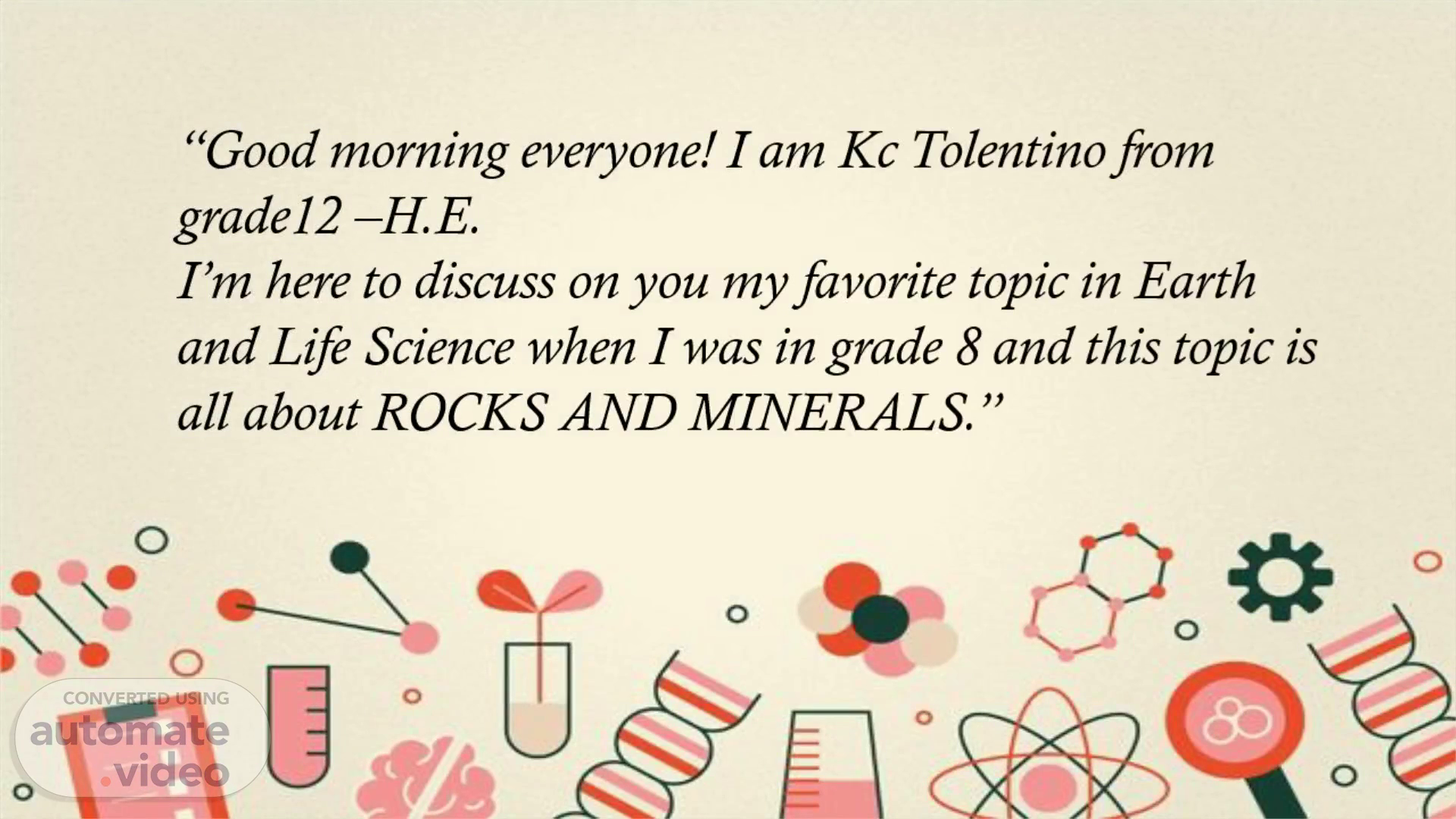
Page 1 (0s)
“Good morning everyone! I am Kc Tolentino from grade12 –H.E. I’m here to discuss on you my favorite topic in Earth and Life Science when I was in grade 8 and this topic is all about ROCKS AND MINERALS.”.
Page 2 (14s)
So, let us know first what is ROCKS AND MINERALS ?.
Page 3 (31s)
What are the difference between a Rock and a Mineral?.
Page 4 (45s)
Now, Let us know the PHYSICAL PROPERTIES OF MINERALS.
Page 5 (53s)
The color of a mineral when it is powdered is called the streak of the mineral..
Page 6 (1m 2s)
The luster of a mineral is the way its surface reflects light..
Page 7 (1m 10s)
Hardness-Mohs Scale.
Page 8 (1m 17s)
CLEAVAGE. CLEAVAGE is the way a mineral Breaks..
Page 9 (1m 25s)
FRACTURE. Fracture is a breakage that is not flat. The two main kinds of fracture are conchoidal (shell -shaped, as in quartz) and uneven..
Page 10 (1m 36s)
Heft is how heavy a mineral feels in the hand , an informal sense of density. Taste is definitive for halite(rock, salt) of course, but a few other evaporite minerals also have distinctive tastes..
Page 11 (1m 49s)
After knowing about Minerals, Let us now move on in Rocks.
Page 12 (2m 0s)
ROCK CLASSIFICATION.
Page 13 (2m 7s)
Igneous Rocks. Igneous rock is formed through the cooling and solidification of magma or lava. The magma can be derived from partial melts of existing rocks in either a planet's mantle or crust..
Page 14 (2m 19s)
Igneous textures are used by geologists in determining the mode of origin of igneous rocks and are used in rock classification. There are six main types of textures; phaneritic, aphanitic, porphyritic, glassy, pyroclastic and pegmatitic..
Page 15 (2m 33s)
SEDIMENTARY ROCKS. Sedimentary rocks are types of rock that are formed by the accumulation or deposition of mineral or organic particles at Earth's surface, followed by cementation. Sedimentation is the collective name for processes that cause these particles to settle in place..
Page 16 (2m 48s)
SEDIMENTARY ROCKS. Clastic sedimentary rocks form from the accumulation and lithification of mechanical weathering debris..
Page 17 (2m 57s)
SEDIMENTARY ROCKS. Chemical sedimentary rock forms when mineral constituents in solution become supersaturated and inorganically precipitate. Common chemical sedimentary rocks include oolitic limestone and rocks composed of evaporite minerals, such as halite (rock salt), sylvite, baryte and gypsum..
Page 18 (3m 17s)
METAMORPHIC ROCKS. Metamorphic rocks were once igneous or sedimentary rocks, but have been changed (metamorphosed) as a result of intense heat and/or pressure within the Earth's crust. They are crystalline and often have a “squashed” (foliated or banded) texture..
Page 19 (3m 32s)
TEXTURE. FOLIATED NON*FOLfA.
Page 20 (3m 38s)
Foliation in geology refers to repetitive layering in metamorphic rocks. Each layer can be as thin as a sheet of paper, or over a meter in thickness. The word comes from the Latin folium, meaning "leaf", and refers to the sheet-like planar structure. It is caused by shearing forces, or differential pressure..
Page 21 (4m 1s)
FOLIATED.
Page 22 (4m 7s)
NON-FOLIATED.